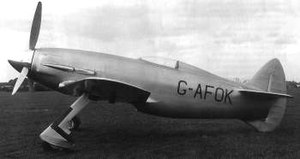Napier-Heston Racer
| Type 5 Racer | |
|---|---|
 |
|
| Napier-Heston Racer at Heston airfield, c. 1940 | |
| Role | Single seat racing monoplane |
| Manufacturer | Heston Aircraft Company Ltd |
| First flight | 12 June 1940 |
| Retired | 1940 |
| Number built | 1 |
The Napier-Heston Racer, also referred to as the Heston Type 5 Racer or Heston High Speed Aircraft J.5, was a 1940s British single-seat racing monoplane first conceived by D. Napier and Son Ltd., and built by the Heston Aircraft Company Ltd, for an attempt on the World Air Speed Record. The private venture was financed by William Morris, Lord Nuffield.
The Napier-Heston Racer design team was led by Arthur Ernest Hagg of Napier & Son, and George Cornwall of Heston Aircraft Company Ltd. It was a single-engined, low-wing cantilever monoplane, purpose-built as a contender for the World Speed Record. It was built almost entirely of wood, that served to ensure rapid construction, a "superfine" finish, and streamlined, "beautiful" lines. The use of a multi-ducted belly scoop and clear, low profile perspex canopy, along with a reputed 20 coats of hand-rubbed lacquer also contributed to the sleek aerodynamic finish. Saunders-Roe provided wing spars made of "Compregnated wood", a system that involved multiple laminations bonded with resin under high pressure.
Diminutive, thin-sectioned symmetrical wing airfoils were designed for high-speed flight. The elevator control circuit was designed by Heston Aircraft Company's Chief Draughtsman, C.G.W Ebbutt, with a variable ratio- with the stick near the neutral position, large movements could be made with small resulting pitch movements. This was needed for accurate handling at low level and high speed (the 3 km airspeed record course had to be flown under 100 ft above sea level). Towards the ends of the control column movement, the ratio increased to allow utilization of the full range of elevator travel.
The aircraft’s design parameters were purposely designed around a top secret, untested, 24-cylinder, 2,450 hp liquid-cooled Napier Sabre engine. Although originally proposed to the Air Ministry and receiving approval as primarily an engine programme, the Napier-Heston Racer was ultimately not officially sanctioned and had to proceed as a private venture with Lord Nuffield entirely underwriting the project.
...
Wikipedia
